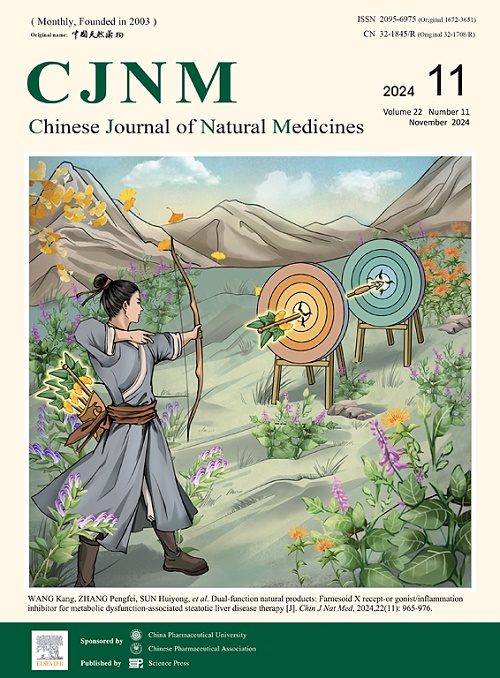Identification and biomimetic synthesis of iphionanes and cyperanes from Artemisia hedinii and their anti-hepatic fibrosis activity
IF 4.9
2区 医学
Q1 INTEGRATIVE & COMPLEMENTARY MEDICINE
引用次数: 0
Abstract
Two novel skeleton sesquiterpenoids (1 and 6), along with four new iphionane-type sesquiterpenes (2−5) and six new cyperane-type sesquiterpenes (7−11), were isolated from the whole plant of Artemisia hedinii (A. hedinii). The two novel skeleton compounds (1 and 6) were derived from the decarbonization of iphionane and cyperane-type sesquiterpenes, respectively. Their structures were elucidated through a comprehensive analysis of spectroscopic data, including high-resolution electrospray ionization mass spectrometry (HR-ESI-MS) and 1D and 2D nuclear magnetic resonance (NMR) spectra. The absolute configurations were determined using electronic circular dichroism (ECD) spectra, single-crystal X-ray crystallographic analyses, time-dependent density functional theory (TDDFT) ECD calculation, density functional theory (DFT) NMR calculations, and biomimetic syntheses. The biomimetic syntheses of the two novel skeletons (1 and 6) were inspired by potential biogenetic pathways, utilizing a predominant eudesmane-type sesquiterpene (A) in A. hedinii as the substrate. All compounds were evaluated in LX-2 cells for their anti-hepatic fibrosis activity. Compounds 2, 8, and 10 exhibited significant activity in downregulating the expression of α-smooth muscle actin (α-SMA), a protein involved in hepatic fibrosis.
青蒿中伊菲酮类和环己烷类的鉴定、仿生合成及其抗肝纤维化活性
从黄花蒿(Artemisia hedinii, A. hedinii)全株中分离到2个新的骨架倍半萜(1和6),4个新的伊菲烷型倍半萜(2−5)和6个新的环己烷型倍半萜(7−11)。这两个新的骨架化合物(1和6)分别是由伊菲酮型和环己烷型倍半萜脱碳而得。通过对高分辨率电喷雾电离质谱(HR-ESI-MS)和核磁共振(NMR)光谱的综合分析,阐明了它们的结构。通过电子圆二色性(ECD)光谱、单晶x射线晶体学分析、时变密度泛函理论(TDDFT) ECD计算、密度泛函理论(DFT)核磁共振计算和仿生学合成确定了绝对构型。这两种新型骨架(1和6)的仿生合成受到潜在生物遗传途径的启发,利用了a . hedinii中占优势的桉烷型倍半萜(a)作为底物。在LX-2细胞中评估所有化合物的抗肝纤维化活性。化合物2、8和10在下调α-平滑肌肌动蛋白(α-SMA)表达方面表现出显著活性,α-SMA是一种参与肝纤维化的蛋白。
本文章由计算机程序翻译,如有差异,请以英文原文为准。
求助全文
约1分钟内获得全文
求助全文
来源期刊

Chinese Journal of Natural Medicines
INTEGRATIVE & COMPLEMENTARY MEDICINE-PHARMACOLOGY & PHARMACY
CiteScore
7.50
自引率
4.30%
发文量
2235
期刊介绍:
The Chinese Journal of Natural Medicines (CJNM), founded and sponsored in May 2003 by China Pharmaceutical University and the Chinese Pharmaceutical Association, is devoted to communication among pharmaceutical and medical scientists interested in the advancement of Traditional Chinese Medicines (TCM). CJNM publishes articles relating to a broad spectrum of bioactive natural products, leading compounds and medicines derived from Traditional Chinese Medicines (TCM).
Topics covered by the journal are: Resources of Traditional Chinese Medicines; Interaction and complexity of prescription; Natural Products Chemistry (including structure modification, semi-and total synthesis, bio-transformation); Pharmacology of natural products and prescription (including pharmacokinetics and toxicology); Pharmaceutics and Analytical Methods of natural products.
 求助内容:
求助内容: 应助结果提醒方式:
应助结果提醒方式:


